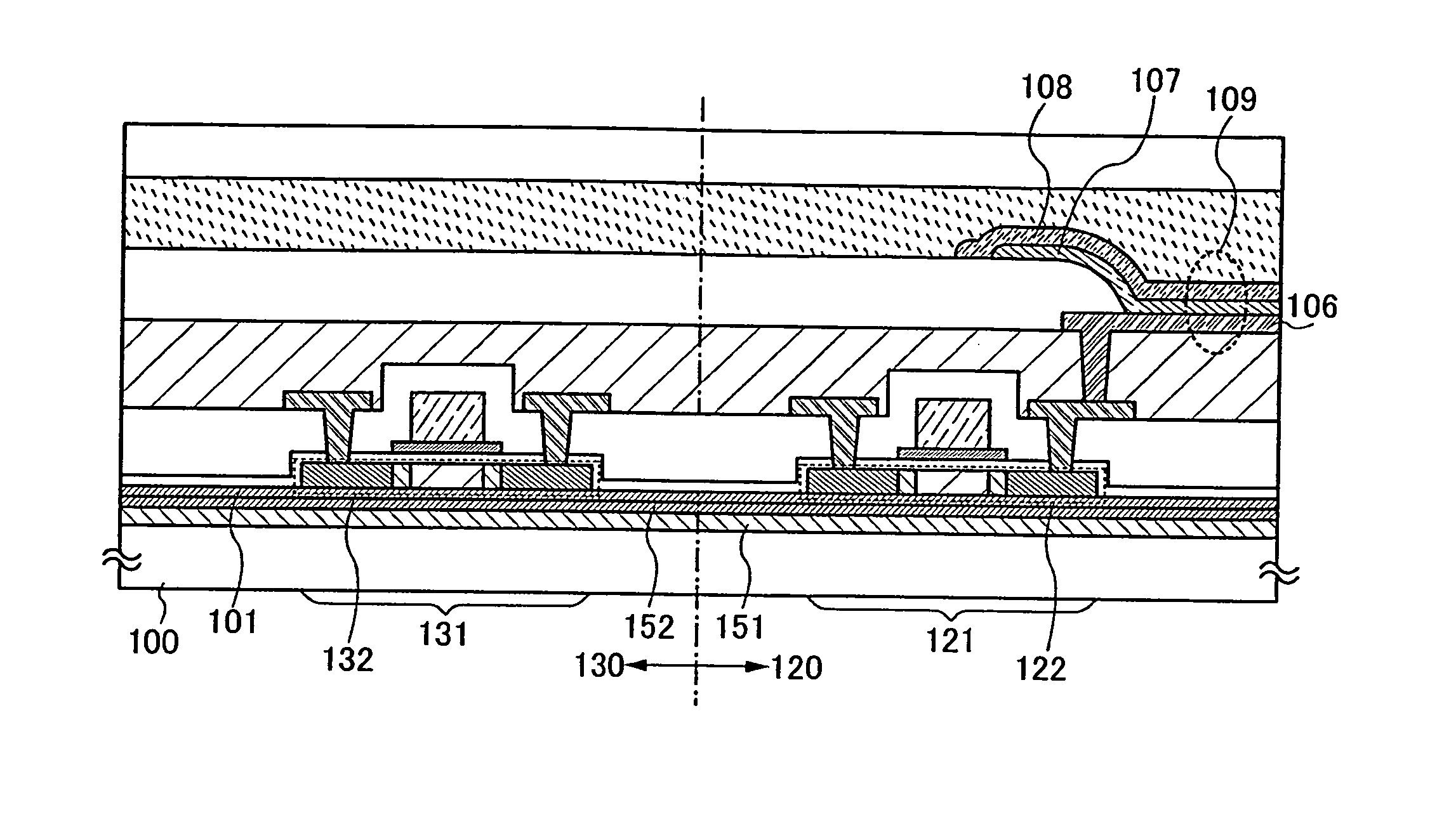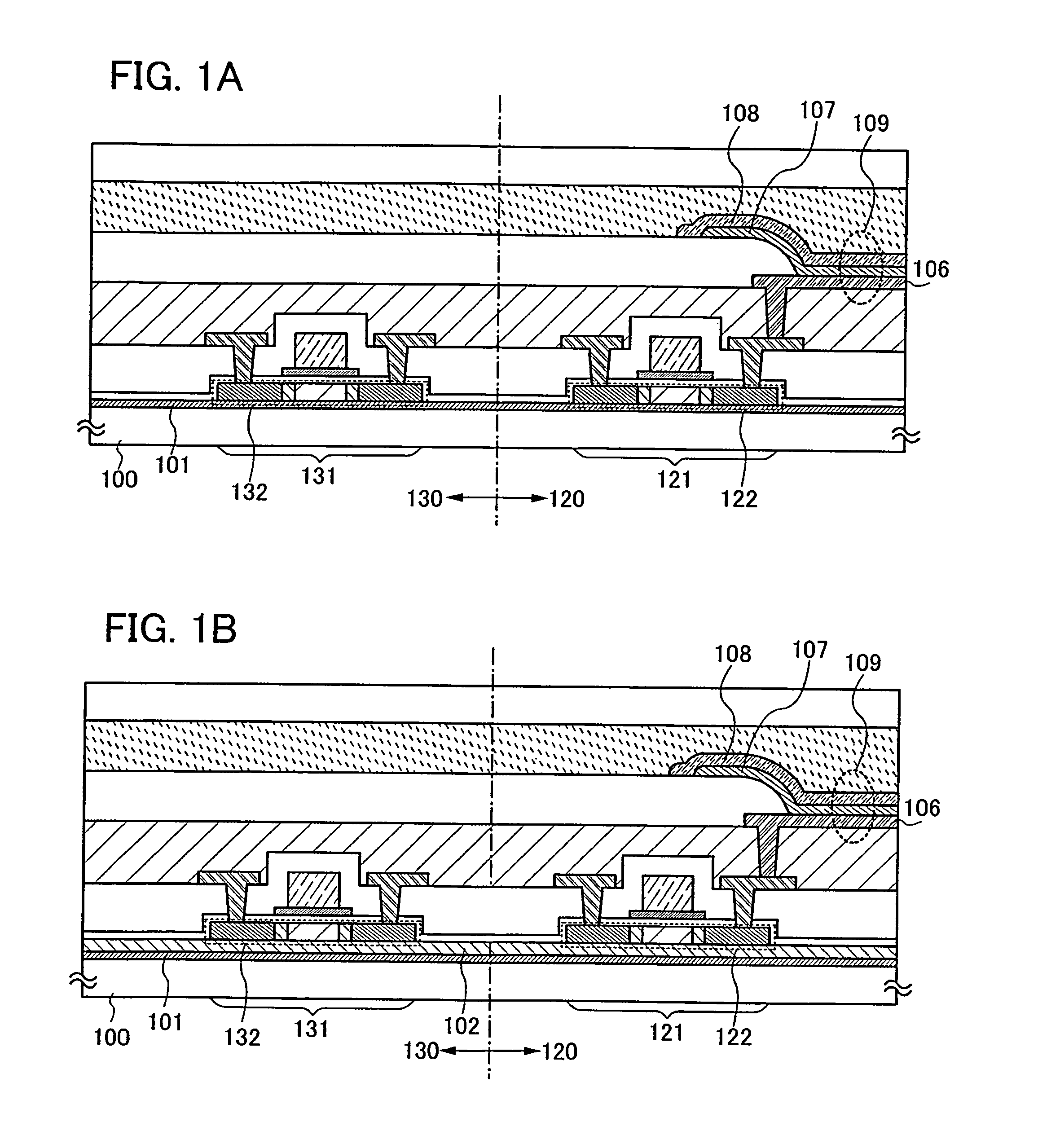Light-emitting device
a light-emitting device and light-emitting technology, which is applied in the direction of static indicating devices, identification means, instruments, etc., can solve the problems of affecting the display of the light-emitting device by tfts, the effect of reducing the characteristics of transistors between different pixels, suppressing the luminance change accompanies deterioration of light-emitting elements or the lik
- Summary
- Abstract
- Description
- Claims
- Application Information
AI Technical Summary
Benefits of technology
Problems solved by technology
Method used
Image
Examples
embodiment mode 1
[0056]This embodiment mode describes an example of the structure of a light-emitting device and a method for manufacturing the light-emitting device with reference to the drawings. A light-emitting device described in this embodiment mode uses an SOI (silicon on insulator) substrate. The SOI substrate can be formed by a bonding SOI technique. A light-emitting device manufactured using an SOI substrate in which a single-crystal semiconductor layer is bonded to a substrate having an insulating surface, such as glass, is described with reference to the drawings.
[0057]The structures of light-emitting devices in this embodiment mode are described with reference to FIGS. 1A and 1B. FIGS. 1A and 1B each show a pixel portion of a light-emitting device and a driver circuit portion which controls operation of the pixel portion.
[0058]A light-emitting device shown in FIG. 1A is provided with a transistor 121 included in a pixel portion 120 and a transistor 131 included in a driver circuit porti...
embodiment mode 2
[0160]This embodiment mode describes a method for manufacturing an SOI substrate, which is different from that in the above-described embodiment mode, with reference to the drawings.
[0161]First, a semiconductor substrate 161 is washed with a sulfuric acid / hydrogen peroxide mixture (SPM), an ammonia peroxide mixture (APM), a hydrochloric acid / hydrogen peroxide mixture (HPM), diluted hydrogen fluoride (DHF), or the like, as appropriate. Then, thermal oxidation of the semiconductor substrate 161 is performed to form an oxide film 190 (see FIG. 31A). Although the thermal oxidation may be conducted by dry oxidation, the thermal oxidation is preferably performed by oxidation in an oxygen atmosphere to which halogen is added. As a material including halogen, HCl is typical, and alternatively, one or more of HF, NF3, HBr, Cl2, ClF3, BCl3, F2, Br2, or the like can be used. As an example of such thermal oxidation, thermal oxidation may be conducted at 900 to 1150° C. (typically, 1000° C.) in ...
embodiment mode 3
[0176]This embodiment mode describes an example of a light-emitting device with reference to the drawings.
[0177]FIG. 8 shows a block diagram of an active-matrix EL display device. The EL display device includes a driver circuit portion formed of a scanning line driver circuit 251, a signal line driver circuit 252, and the like, and a pixel portion 120 in which a plurality of pixels 253 is arranged.
[0178]A signal output from the signal line driver circuit 252 is input to signal lines S1 to Sx and transferred to each pixel 253. A signal output from the scanning line driver circuit 251 is input to scanning lines G1 to Gy and transferred to each pixel 253. Power supply lines V1 to Vx are arranged to be parallel to the signal lines and supply current to each pixel 253.
[0179]The EL display device described in this embodiment mode can have a structure in which the driver circuit portion including the scanning line driver circuit 251, the signal line driver circuit 252, and the like and the...
PUM
 Login to View More
Login to View More Abstract
Description
Claims
Application Information
 Login to View More
Login to View More - R&D
- Intellectual Property
- Life Sciences
- Materials
- Tech Scout
- Unparalleled Data Quality
- Higher Quality Content
- 60% Fewer Hallucinations
Browse by: Latest US Patents, China's latest patents, Technical Efficacy Thesaurus, Application Domain, Technology Topic, Popular Technical Reports.
© 2025 PatSnap. All rights reserved.Legal|Privacy policy|Modern Slavery Act Transparency Statement|Sitemap|About US| Contact US: help@patsnap.com



